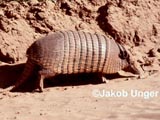Six-banded Armadillo
One species of six-banded armadillo (E. sexcinctus) is recognized. This animal is also known as the yellow armadillo.
Euphractus sexcinctus
Six-banded Armadillo or Yellow Armadillo
- Range:
Surinam and east of the Andes from the Amazon basin in Brazil to central Argentina and Uruguay.
- Size and Weight:
Head and body length: 401 — 495 mm (15.8 — 19.5 in).
Tail length: 119 — 241 mm (4.7 — 9.5 in).
Weight: 3.2 — 6.5 kg (7.1 — 14.3 lbs).- Description:
Yellow to red-brown in color. Most individuals are moderately hairy. The head is pointed and flattened. E. sexcinctus has 6 to 8 moveable bands on the shell, and two to four distinctive bands of plates around the base of the tail. Holes in several of the plates above the base of the tail are apparently openings for scent glands. All five toes on the front feet have claws. The longest claw is on the second toe. The skull is relatively heavy, with stronger jaws than seen in other armadillo species. Although the teeth lack enamel, they are relatively strong. The six-banded armadillo generally has 9 pairs of teeth in the upper jaw, and 10 pairs in the lower jaw. They may have 6 to 7 moveable bands in the shell. Unlike most armadillo species, E. sexcinctus can develop fairly thick deposits of fat under the skin.
- Habitat:
Dry savannah, or drier parts of wet savannah.
- Ecology:
E. sexcinctus seems to be the most common type of armadillo in Argentina. They dig dens in dry areas. Unlike most armadillo species, six-banded armadillos are diurnal, and remain active even under bright daylight. They also are known to use the same den site for quite some time before leaving them. Most species of armadillo abandon dens after only one or two days. The six-banded armadillo may scent-mark the den site to help establish a territory. The den usually extends one or two meters into the ground, with just enough room at the end hollowed out for the animal to turn around. When digging, E. sexcinctus piles dirt underneath it with the front claws, and then uses the hind claws to throw the piled dirt out behind it.
The diet mostly consists of plant material and insects, although they will eat scraps from animal carcasses. E. sexcinctus is solitary, but are sometimes seen in gatherings around carcasses to feed on maggots and bits of decaying flesh. The minimum observed home range is 93.3 ha (230.5 acres). E. sexcinctus is an occasional agricultural pest, sometimes feeding on sprouting corn and other crops. They are sometimes hunted as a food source, but are not preferred as the meat reportedly has a strong flavor.
- Biology:
Gestation period is 60 to 65 days. Young are born year-round. 1 to 3 young may be born per litter; generally two are born, and can be of both sexes. Females have two mammae to provide for the newborns. Pups are born with the eyes closed. They make clicking and squeaking sounds to elicit a response from the mother. The eyes open at 22 to 25 days, and the young begin to take solid food at 30 days. They are sexually mature at 9 months. One specimen lived 18 years in captivity.
- Pictures:
-
Do you have a picture of E. sexcinctus that you would like to donate to this site? Please see the Armadillos Wanted page to see how you can help.
- Anatomical Images:
-
Anatomical specimens hosted by and © University of Michigan Museum of Zoology Animal Diversity Web; linked with permission.
Sources
Nowak, R.M. 1999. Walker’s Mammals of the World, 6th edition. Johns Hopkins University Press, Baltimore, MD. 158-168.
Redford, K.H. and Wetzel, R.M. 1985. Euphractus sexcinctus. Mammalian Species 252: 1-4.
Abbreviations
IUCN: International Union for Conservation of Nature and Natural Resources
USDI: United States Department of the Interior
CITES: Convention on International Trade in Endangered Species of Wild Fauna and Flora
 ] will leave this website.
] will leave this website.







